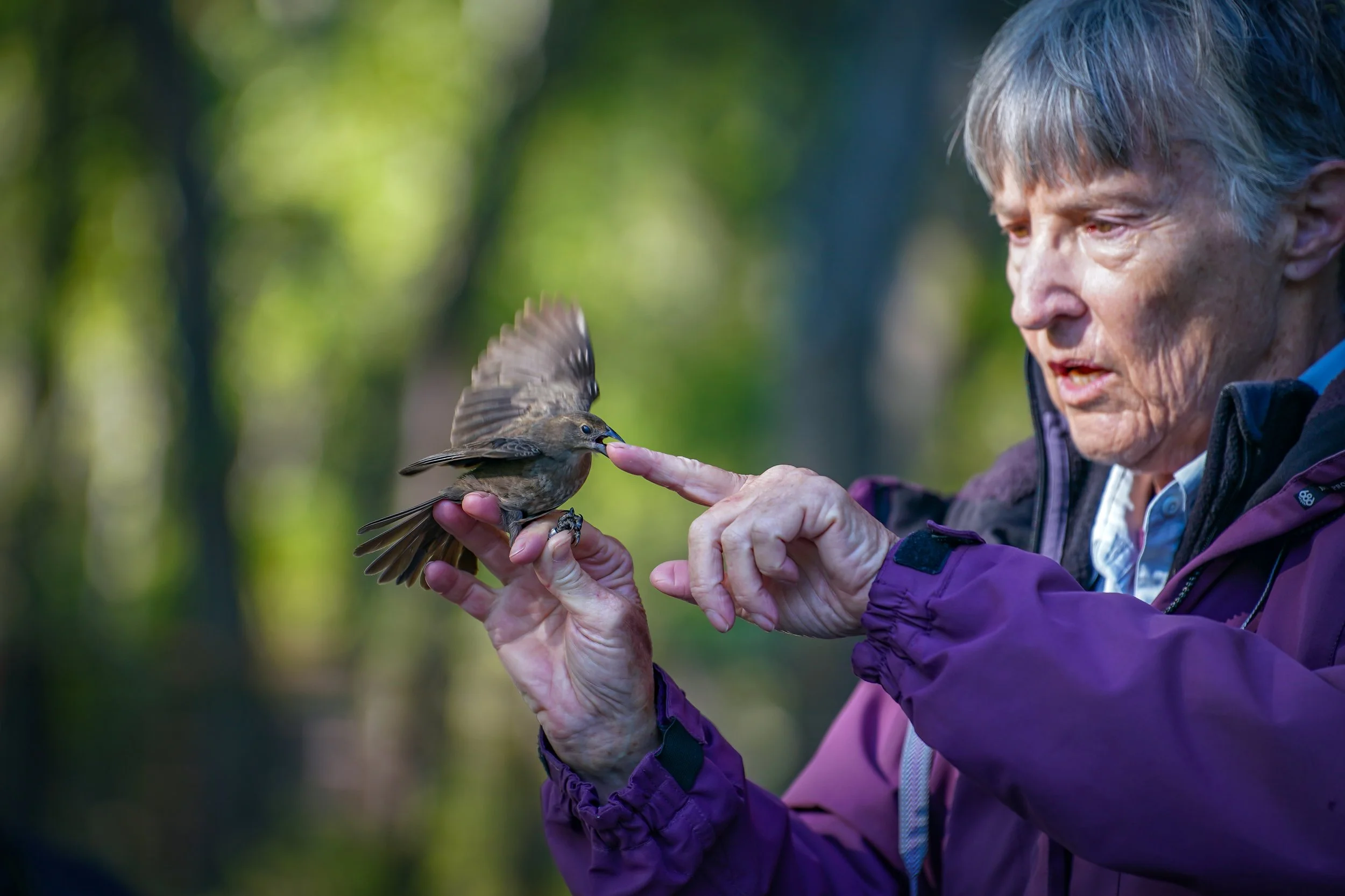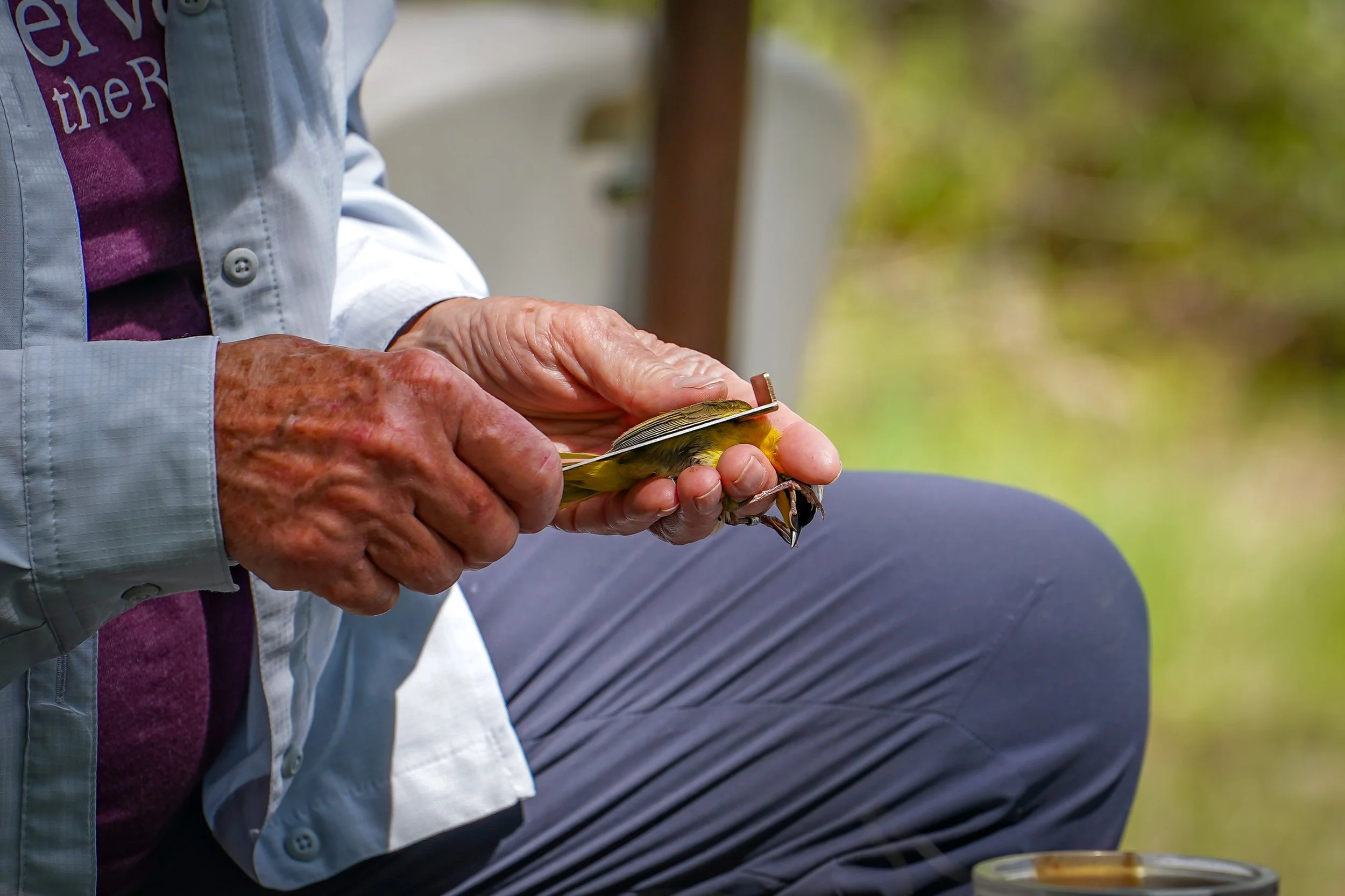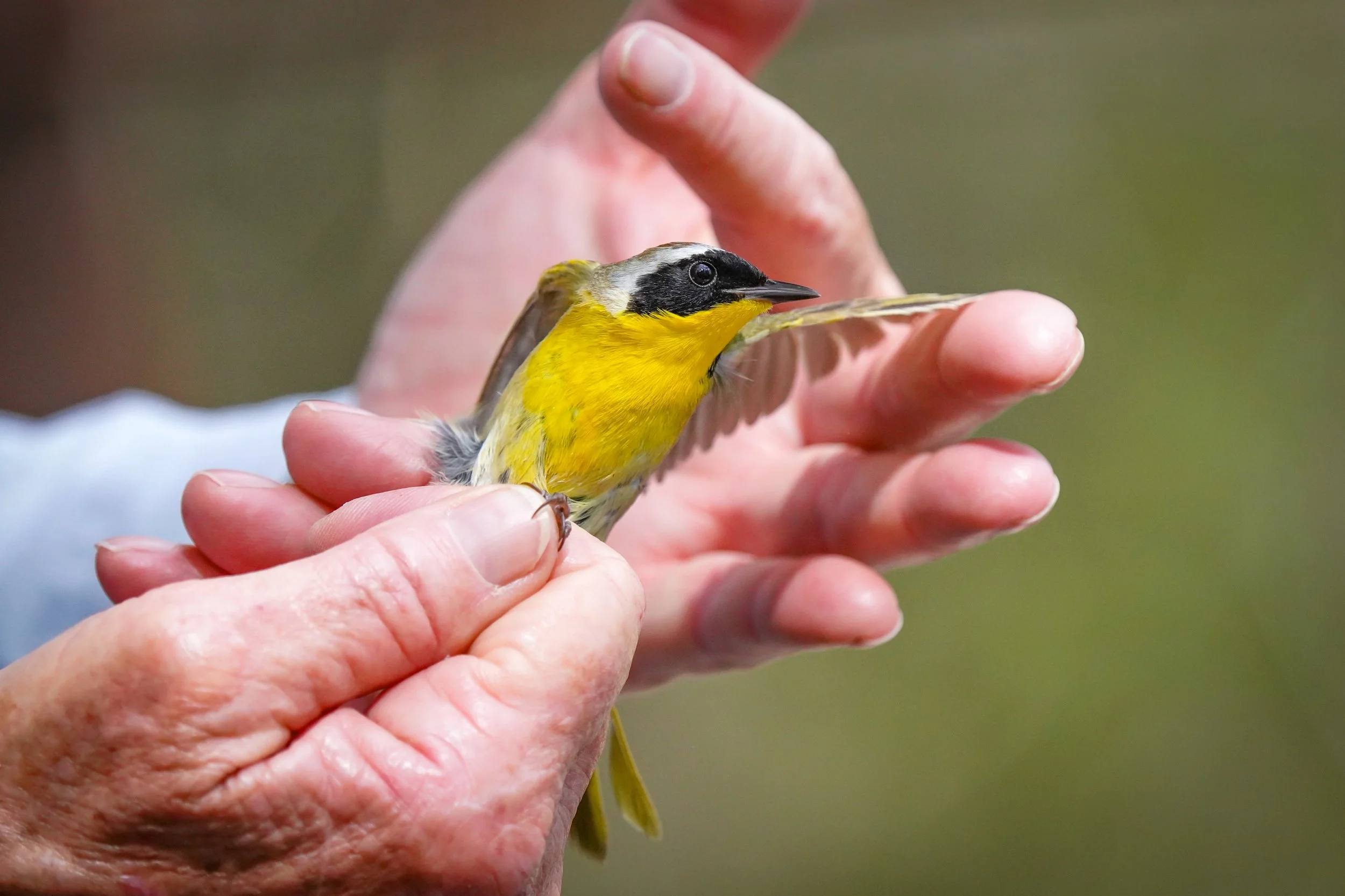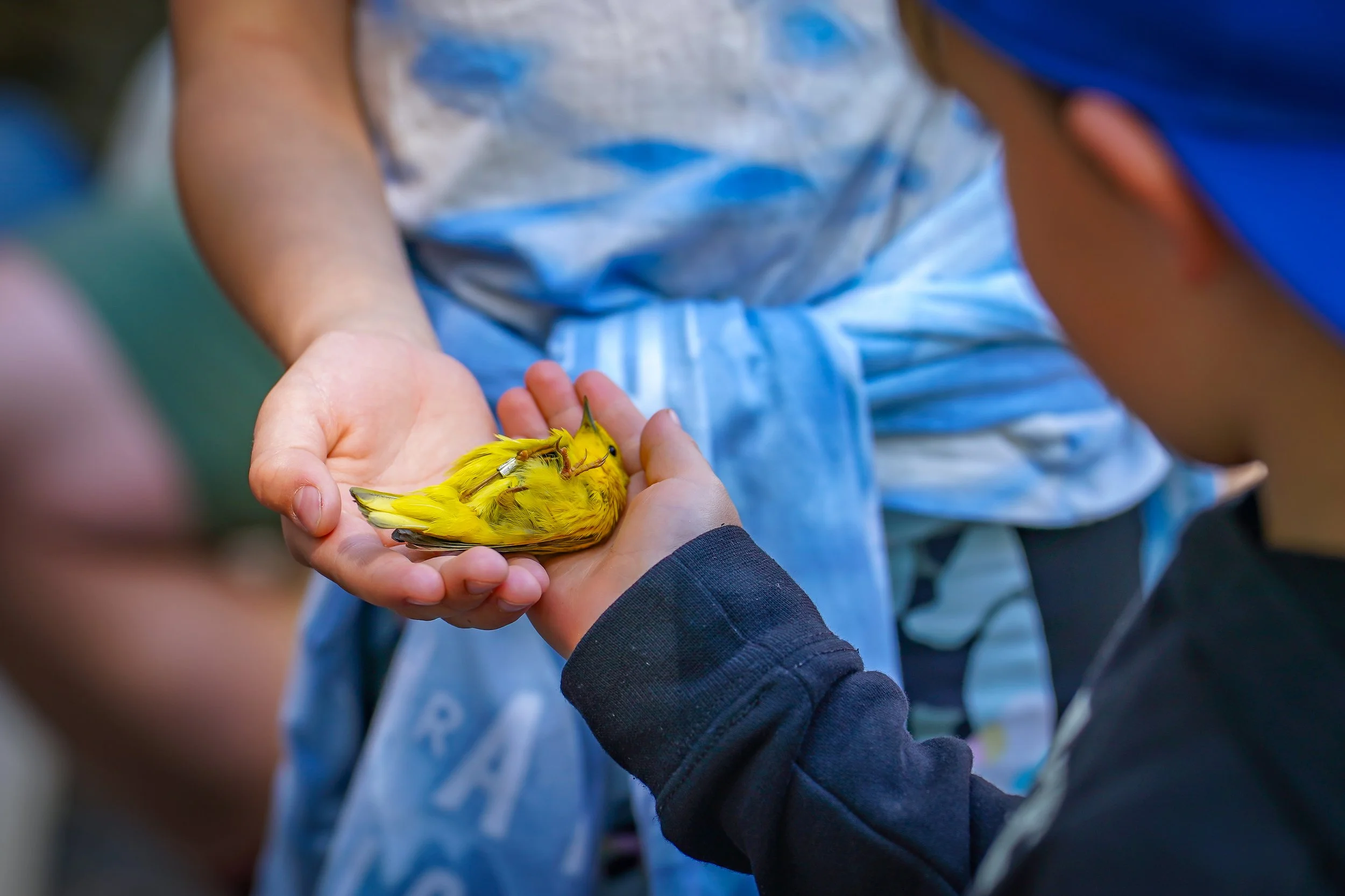Bird Banding with Denver Audubon
June 10, 2024
As I may have mentioned previously, this year I decided to become a volunteer with Denver Audubon. In 2023, this organization gave me so much - knowledge, experience, connections, and fun - that I had to give back. When I launched my Etsy Store in November of 2023, I decided I would donate 15% of my profits to Denver Audubon. Now in 2024, I’ve expanded that and will be donating 15% of profits on sales of “bird items” to Denver Audubon and Audubon Rockies - and that’s when I decided I also wanted to volunteer.
For my very first volunteer shift on May 19, I got to lead participants to the Bird Banding station that’s set up at the Denver Audubon’s Kingery Nature Center, on the south end of Chatfield State Park! I assumed I would just walk participants to the station, answering questions and providing information, then go back to the main entrance on a repeat cycle for my 4 hour shift….but instead, I actually got to hang out and watch the banding process and take photos the whole time! It was very special and now I’d like to share it with you and encourage you to also attend a bird banding session. You will never forget it!
Meredith McBurney, certified bird bander with Bird Conservancy of the Rockies, holds a Yellow Warbler and talks details about the bird with the participants - May 2024
Each spring and fall, migratory birds are banded at various stations along the front range, and even in locations in Nebraska, so they can be assessed for a variety of things - like size, weight, fat reserves, plumage condition, age, and sex. Bird migration is a well-timed event, often taking migratory birds thousands of miles in a matter of weeks. Each year, the timing gets a little harder due to changes in weather patterns and global temperatures that affect the growth cycle of plants and thus the hatching cycles of insects - both of which the birds heavily rely upon during their journeys.
The birds with the shorter migrations - usually ones that only travel, say, a couple hundred miles, or ones that live in a place most or all of the year, will have a much better chance at survival and raising young. They can adapt more quickly to local climate-related changes on plants and insects. The birds traveling thousands of miles begin their journeys based on instinct, not knowing what lies ahead for them. If they get to a place too early or too late, they are more likely to perish and they may not successfully get to nest and raise young before their food source is gone.
Birds are remarkable at adapting to change, but when change happens too quickly or humans wipe out entire areas where birds had previously migrated to nest, they cannot survive. Birds have a very strong instinct to return to their nesting grounds, an instinct so powerful, that bird banding stations have had birds return up to and more than a decade later! These are some hardy birds - ones that have miraculously found a way to survive through more than 10 years of weather changes, environmental changes, food supply variations, human-imposed changes to nesting grounds, and more! Birds may be delicate, but they have an unwavering drive to survive.
The birds aren’t always thrilled to be held, like this female Brown-Headed Cowbird!
The process of bird banding is relatively quick to ensure birds do not suffer any ill effects from being caught and handled. The bird banders are a well-oiled team, certified by the federal government to handle birds and conduct these banding surveys. The teams survey the capture nets every 20 minutes, taking birds out of the net to place in the soft cloth bags, or release if they are not the intended target. Once collected, the birds remain in the bags and are placed on a grid from the retrieval location. Birds are taken out of bags one at a time, where they have wing and tail measurements taken. A tail feather may be plucked if the bird is within a study group of avian genetics. The bird is weighed and then there is a check to see if the bird has any fat reserves. Depending on the bird and how far its migration is, the presence or absence of fat reserves can give the banders a good idea of the birds general health and point in migration. If a bird has no fat reserves, they are likely stopping by for a brief visit to load up on food for the next stage of their journey. After measurements are taken, the birds are then banded and all the information is recorded. The birds are then gently released. The whole process only takes a couple of minutes.
Click on each photo below for a larger image…
This year, Meredith stated the overall numbers of birds getting bands is one of the lowest number years she’s seen. This pattern seemed to apply to stations across Colorado. While reasons for why aren’t cut and dry, she did reiterate how climate changes have made significant impacts on the timing of vegetation and insect numbers/blooms/hatches and birds being able to time it correctly in order to have enough food to raise the next generation (and keep themselves alive).
Bird Banding has been a great way to keep tabs on bird species and population numbers, but it has limited success in telling the whole story. When birds are caught again, it helps the organizations get a peek into how old migrating birds are and their health at the time of migration. But new technologies are being developed so scientists can get a year-round look at bird lives; where they travel, how they pick where to stop and refuel, and how they time their movements. There are real-time cellular trackers that can now be used on larger birds (like bald eagles), which have helped scientists understand these birds much better. However, tiny migrating birds can’t carry any heavy trackers, so scientists really have their work cut out for them!
In the meantime, the general population can greatly help scientists with collecting this information! If you are a bird enthusiast, I recommend you check out these applications for your phone: Audubon, eBird, and Merlin. These 3 apps allow you to record bird sightings, learn about birds in your area (Audubon app only covers North American birds), and sound/photo ID birds you see. On eBird, you can contribute birding lists that help document population densities in your area. These lists are reviewed by experts and then compiled into a worldwide database. Birds can use all the help they can get!
Overall, this was a really terrific experience and chance to get up close and personal with some very beautiful birds! Bird banding activities can be found in many locations across the front range and with a number of organizations, including Denver Audubon and Bird Conservancy of the Rockies. I highly recommend checking out both of these organizations and signing up to attend a bird banding session!
















